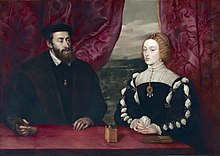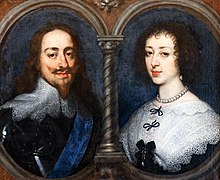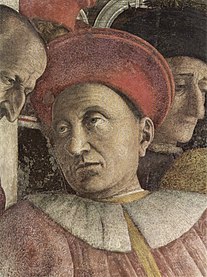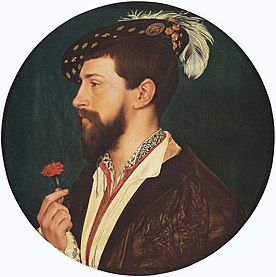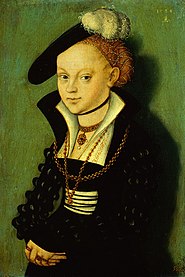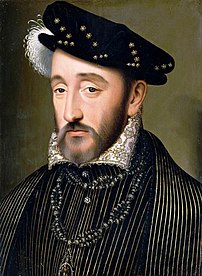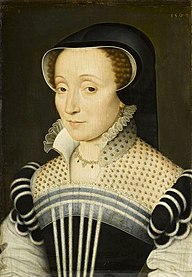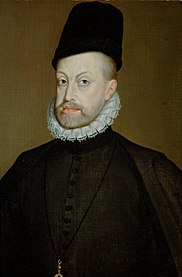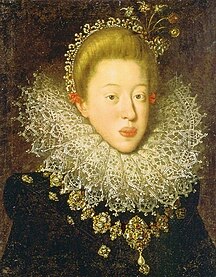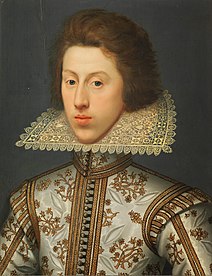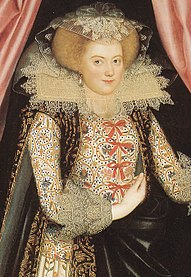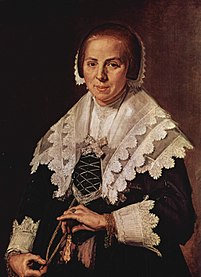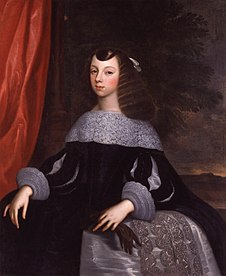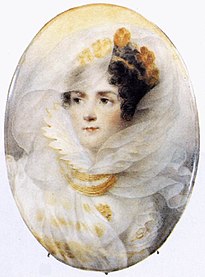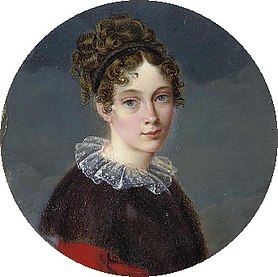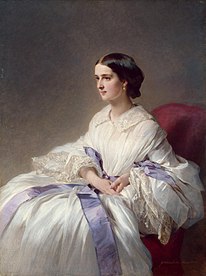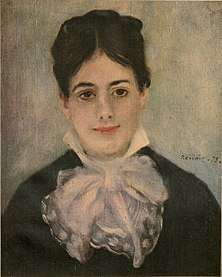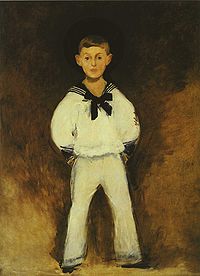Collar (clothing)

The collar (plural: the collar , regionally also the collars ) has been a decorative element on clothing since the 13th century . Once only attached to the jacket , then also to the shirt , the shape of the collar was influenced by political and ecclesiastical authorities and dress codes , and later by industrialization , mechanization and, last but not least, by fashion and the respective way of life .
The collar has its counterpart in the cuff , both of them often had a certain formal similarity, referred to each other and complemented each other.
development
Up until the high Middle Ages , garments did not have a collar. It was not until the late Middle Ages that "a narrow stripe at the neckline" was occasionally found, and in the Burgundian court costume of the 15th century, a narrow stand-up collar developed on the doublet of men and women, from which a narrow white collar or the tips of one developed white collar look out. Also in the 15th century people loved to dress their coats with fur, from which a fur collar was made.
However, even in the Renaissance, robes often did not have a collar. For men, however, a neckline was fashionable from which a pleated undershirt peeked out. A standing cuff was often attached to this shirt, which was often embroidered and had a tiny frill towards the top. The same applies to women's clothing. From this the ruff was created after 1550.
Between approx. 1530 and 1550, simple white collars with two points emerged more and more often, especially in men's clothing, which protrude from a dark outer garment and already have a great resemblance to the modern shirt collar; At a ripe old age, Emperor Charles V seems to have had a preference for this little white collar and was often painted with it, especially by his court painter Titian .

A heyday of the most varied and imaginative collar shapes for both women and men began in the second half of the 16th to around the middle of the 17th century - including different types of starched and pleated ruff made of fine linen , the largest of which was a millstone ruff went down in history. The ruff was also set with lace and at times took on such large shapes that the handles of the spoon were lengthened so that the food could be brought to the mouth. In Spain, dress codes later banned oversized luxury and introduced a simple, small, plate-shaped collar for men, the golilla . It was also sometimes worn outside of Spain.

In addition to the ruff, there were also different types of stand-up collars at the same time between around 1580 and around 1630 - with and without lace, smooth or pleated, including the Stuart collar or Medici collar, which gave aristocrats a royal look in particular. Large plate collars in various shapes and sizes - round, semicircular or square - were very often made from starched lace, and were especially worn by women.
After 1600, a formally simple, lying collar made of linen or batiste appeared in men's fashion , but it could also take on larger dimensions and, if one could afford it, was also very often decorated with expensive lace or made entirely of lace. The ladies of the early baroque style covered their necklines with similar collars, which were, however, more expansive and more imaginative in their shapes .
At the time of Louis XIV , the Sun King, the collar almost completely disappeared under the allonge wig , only a jabot adorned the breast slit of a man's shirt - but this was originally made from a lace tie and is not a collar in the strict sense. Since 1650 at the latest, large necklines appeared in women's fashion, some of which were initially set with a lace collar. However, this soon disappeared from women's fashion and for about 150 years, although the lace-embellished edge of the undershirt was sometimes exposed.
At the time of the French Revolution after 1790, eye-catching collar decorations were dispensed with and in men's fashion the collar end was simply held up with wide scarves with many different types of binding.
In women's fashion of the 19th century, high-necked dresses were sometimes based on early baroque collar shapes, even on the ruff, which, however, was only in fashion at times in a soft, non-starched and romantic form. In the Biedermeier period , the huge, often shoulder-free décolleté was surrounded by large collars, which are known in technical jargon as Berthe . Overall, in the 19th century there are significantly more and more imaginative collar shapes in women's fashion than in men, who from now on appear more objective.
The patricide in men's fashion of the Biedermeier period was a stand-up collar with a stiffened neck part and stiff and pointed collar parts that reached down to the cheeks. Towards the end of the 19th century, the collar became smaller and, in combination with a bow , bow tie or tie, took on an appearance that is still current today (as of 2020). The fixed collar was replaced by a button-off collar made of paper or rubber . A chemisette , a vest, was worn over the (possibly differently colored) shirt .
As a result of industrialization and thus the assembly of clothing, individual items of clothing such as blouses or shirts became simpler but also more independent in the 20th century. B. can also look representative without a jacket . In today's fashion, collars are cut comfortably and functionally and show different shapes - however, the excessive fantasy and luxury that were once pursued around the collar seem to be a thing of the past. Inlay processing gives the men's collar in particular support despite the fact that the collar stiffeners have been omitted .
Different collar shapes over the centuries (gallery)
After Rogier van der Weyden : Johann I von Kleve (1419–1481), around 1460. The red stand-up collar of the doublet protrudes from the fur-trimmed coat.
A very rare example of a real collar in the 15th century. ( Andrea Mantegna : Ludovico II. Gonzaga , Camera degli sposi , Mantua , 1474)
Hans Holbein the Elder J .: Simon George, ca.1533
Lucas Cranach the Elder J .: Christiane von Eulenau , 1534 (Dresden)
François Clouet : Henry II of France , 1559
Alonso Sánchez Coello : Philip II of Spain, 1568
Hans von Aachen : Archduchess Maria of Austria , 1604. Lace ruff
Frans Pourbus : Maria de Medici , 1616. A jagged Medici collar .
Michiel van Mierevelt : Portrait of a Man, 1620s.
Frans Pourbus d. Ä. : Portrait of a Frenchman , ca.1610–1622. A large stand-up collar made of lace.
Frans Hals : Woman with a Fan , ca.1640
After Dirk Stoop: Katharina von Braganza , ca.1660
Godfrey Kneller : Henry Compton , 1712. In the Baroque era, the typical collar of Protestant clergymen, the little buffalo, was created
Jean-Baptiste Isabey : Empress Joséphine , ca.1808
Ingres : Baron Joseph-Pierre Vialetès de Mortarieu , 1st quarter of the 19th century. Example of the famous parricide pile collar.
Francesco Hayez : Antonietta Vitali Sola , 1823
Ingres : Madame Marie Marcotte , 1826
Franz Xaver Winterhalter : Countess Olga Shuvalova , 1858
Auguste Renoir : Smiling Woman ( Madame Fournaise ), 1875. Typical collar with bow from the end of the 19th century
Édouard Manet : Henry Bernstein as a child , 1881. Sailor suit with sailor collar for children.
List of collar shapes
- Armani collar
- Peter Pan collar
- Button-down collar
- Eton collar
- Calyx collar
- Shark collar
- Ruff
- Italian collar
- Kent collar
- Tilt collar
- Flap collar
- Kollar
- Lido collar
- New Kent collar
- Piccadilly collar
- Pierrot collar
- Turtleneck
- Round collar
- Shawl collar
- Stand-up collar
- Stuart collar
- Tab collar
- Vario collar
- Parricide
- Windsor collar
See also
literature
- Ludmila Kybalová, Olga Herbenová, Milena Lamarová: The great image lexicon of fashion - from antiquity to the present , translated by Joachim Wachtel, Bertelsmann, 1967/1977
Web links
Individual evidence
- ↑ Kragen, der , Duden online, accessed on March 8, 2018
- ↑ Ludmila Kybalová, Olga Herbenová, Milena Lamarová: The great image lexicon of fashion - from antiquity to the present , translated by Joachim Wachtel, Bertelsmann, 1967/1977: p. 435.
- ↑ a b Ludmila Kybalová, Olga Herbenová, Milena Lamarová: The great image lexicon of fashion - from antiquity to the present , translated by Joachim Wachtel, Bertelsmann, 1967/1977: p. 399.
